MOTHER EARTH NEWS FAIR
 Visit us at
Visit us at
Mother Earth News Fair
Premier's booth #1221 & 1320
Puyallup, WA
May 31 - June 1, 2014
Premier's booth #151 & 153
Seven Springs, PA
September 12-14, 2014
Premier's booth -- TBA
Topeka, KS
October 25-26, 2014
PIG QUIKFENCE

Pigs can quickly till the soil, so plan to frequently move them to new areas. The result can be an excellent pre-tilled garden.
Pig QuikFence™ 6/30/12
| • |
Simple to install/remove |
| • |
Very effective |
| • |
Portable |
Purpose
To contain pigs in the backyard or pasture rather than a cement lot.
Prefabricated. So it’s easier to use and install than multiple strands of electric wire on posts (and far more effective and reliable as well).
Uses
| • |
As a perimeter or subdivision fence for pasture pigs. |
| • |
Allows pigs to forage gardens, orchards and fields after harvest. |
| • |
To replace welded wire panels, which are heavy and not easy to move. Pig QuikFence is much lighter than hog panels. And you can make a much larger pen for less $$. |
Training pigs to electric fence…
If your pigs have not previously been trained to electric fence, you definitely should do this.
Why? Because pigs new to electric fence may decide to charge forward through the fence instead of backing away.
How? Set up an electric fence alongside (1 to 2 ft away) a secure permanent fence that the pigs can’t get through. Make sure the electric fence is “on.” (At least 3000v at end of fence.) Introduce the pigs to the fence. Monitor the pigs for a few hours.
PREMIER ENERGIZERS

Connecting Premier's PRS 50 Solar Energizer to fencing. It should be slightly tilted toward the south to catch peak sunlight available. We prop one edge on top of the ground rod.
Premier Energizers
| 1. |
110v AC (plug-in)—Energy input is 110v AC. Mount inside buildings or in a protected area outdoors. Connected to ground rods and fence with insulated wires. |
| 2. |
AC/DC—Can either be connected to a 12v battery or plugged directly into a 110v AC outlet.
|
| 3. |
DC (battery)—Input energy is from a 6 or 12 volt DC deep-cycle battery. |
| 4. |
Solar—Consists of a solar panel that’s directly attached to a case which, in turn, encloses a DC energizer and battery. |
Energizer Kits
Why purchase a kit?
Users tell us that kits simplify their purchasing decisions—because electrified fences require energizers, ground rods, accessories, etc. And for those with minimal experience, it’s complicated to choose and buy multiple components and build fences. |
Contact Premier or call 800-282-6631 to speak with one of our fence consultants to help you determine the best energizer for your needs.
You can also view our energizer comparison charts online or in Premier's fencing catalog for help in choosing an energizer.

If it's the end of your fencing season, you'll find our video above on how to get your PRS Solar Energizer ready for fencing season helpful, with instructions and tips the folks at Premier have learned by experience.
|
 |
 |

Premier's Pig QuikFence™ and PRS Solar Energizer. Photo taken at Pat & Cindy Snakenberg's farm, Sigourney, IA. Niman Ranch Pigs.
Growing Pigs on Pasture
Pastures around Premier are greening up, which means folks in our area will soon have their stock on fresh forage. Most folks have cattle or sheep but there are a few around us who raise pastured pigs.
If you're thinking about raising some pigs on pasture this spring, we've tracked down a few articles that apply to exactly that. Even if you're not considering pastured pigs, some of the articles have important information on swine nutritional needs.
EXTENSION NEWS
What are some positives and negatives associated with forage or pasture swine systems?
For decades, forage crops were an essential part of a swine feeding program. The development of synthetic vitamins in the 1950's and the shift toward confinement production systems reduced the use of forages in the swine diet. Today, most producers rely upon complex fortified diets to maintain optimum growth and production.
High-quality forages can still be utilized to simplify the feeding and management of the breeding herd. Sows, for example, can be fed less often with a smaller amount of concentrate when fed high-quality forages. Honeyman and Roush, Iowa State University, showed a feed cost reduction of over $3.00/gilt in a 56-day gestation trial grazing alfalfa. Sows may be more content when fed diets containing a significant amount of forage compared to limit-fed sows.
Some negatives are also connected to feeding forages such as the seasonal availability of pastures, and the low dry matter content of the feed. Contamination of pastures by parasites and/or bacteria are potential problems in non-rotated outdoor systems. Hogs maintained outside have a higher energy requirement due to exercise and weather-related stresses. This may require more feed and cause slower gains and less efficiency.
Read More »
OUTDOOR SWINE PRODUCTION
Growing-Finishing Swine In Outdoor Lots
Oklahoma State University, Oklahoma Cooperative Extension Service
William G. Luce, Extension Swine Specialist
Joseph E. Williams, Professor of Agricultural Economics
Raymond L. Huhnke, Extension Agricultural Engineer
Feeding growing-finishing pigs in a low investment system is usually done in outdoor lots with little or no permanent vegetation. Growing-finishing swine, unlike breeding stock, make poor use of pasture; thus pasture is seldom provided. With proper management, pigs can usually gain as rapidly in outdoor lots as in confinement systems but may require slightly more feed per pound of gain.
The main advantage of the outdoor lot system of finishing hogs is its low initial investment. Disadvantages of feeding hogs in outdoor lots include high labor requirements and less climatic control. It is also difficult to control internal parasites and excessive dust or mud that may complicate any existing disease problems. For additional information concerning economics of swine production with low investment facilities see Fact Sheets 3676, and 3678 through 3683.
Goals
In outdoor lot systems of swine production, hogs should reach market weight (240 lb.) in 180 days or less. Feed efficiency should not exceed 3.5 pounds of feed for each pound of gain from 40 to 240 pounds. In addition, hogs should be produced that yield lean, meaty carcasses. Carcasses should average 30.0 inches or more in length, less than 1.2 inches of backfat at the last rib, 5.0 square inches or more of loin eye and be at least 54% lean meat. Eighty percent or more of the hogs produced should grade USDA No. 1 or 2 when marketed.
Housing
Ideal locations for outdoor lot finishing include sandy soils, shade, good quality water and natural protection. The site should have a slope between 2% and 5% to maintain adequate drainage without causing excess runoff and erosion. The space allotted per pig in outdoor lot systems varies depending on soil type, drainage, amount of rainfall, etc. Usually 100 sq. ft. of lot space is sufficient. While a lot capacity of 50 head is desirable to reduce social stresses, as many as 100 head may be fed in one lot provided they are uniform in size.
Read More »
PASTURING SOWS
Farrowing Sows on Pasture
Oklahoma State University, Oklahoma Cooperative Extension Service
William G. Luce, Extension Swine Specialist
Joseph E. Williams, Professor of Agricultural Economics
Raymond L. Huhnke, Extension Agricultural Engineer
The farrowing of sows on pasture or dirt lots is common in Oklahoma on a small scale. However, large (100 to over 1,000 sows) brood sow operations which farrow in individual farrowing houses on dirt lots or pasture are successful in the Southwest. Even though litter size weaned may not be as large as in confinement operations, this can be a feasible system of swine production for producers of essentially any size.
Lower initial investment per sow unit is one of its main advantages. Often it is easier to control the spread of disease such as TGE or other types of baby pig scours when pigs are farrowed in individual houses compared to a central farrowing house. The disadvantages of using individual farrowing houses include increased labor, operator discomfort and inconvenience, and usually an average decrease in litter size weaned of one-half to one pig. For additional information concerning swine production in pasture-dirt lot systems, see Extension Facts, 3676, 3677, and 3679 through 3683.
Breeding Recommendations
Gilts should be seven to eight months of age and weigh at least 250 pounds before they are bred. To help insure that gilts are cycling and ready to breed by this age, pen them adjacent to a boar pen. The sight and smell of the boar will help induce cycling.
Sows can usually be bred during the first estrus after weaning if the pigs are weaned at four weeks of age or later. However, in some management systems, it may be necessary to permit sows to skip one heat period before rebreeding so as not to get a litter farrowed earlier than desired. Breeding recommendations are given in Table 1.
Pen breeding requires less labor than hand breeding, which accounts for its present popularity. In pen breeding, a boar is turned in with a group of females with the expectation that they will all be bred during a 21-day period.
Hand breeding requires more labor because the boars are not allowed to run with the sows. When a sow is in heat, she is taken to the boar or vice versa.
Read More »
NATIONAL PORK BOARD RECIPE
Pecan-Crusted Pork Tenderloin Pinwheels with Carolina Mustard Sauce

Prep Time:15 minutes
Cook Time: 15 minutes
Servings: 6
|
Ingredients
1 pound pork tenderloin
6 slices bacon
Carolina Mustard Sauce:
3/4 cup mustard
1/2 cup honey
1/4 cup cider vinegar
2 tablespoons ketchup
1 tablespoon brown sugar
2 teaspoons Worcestershire sauce
1 teaspoon hot pepper sauce
Pecan Crust:
1 cup pecans, finely chopped
1 teaspoon salt
1/2 teaspoon black pepper
Cooking Directions
Cut pork lengthwise into six 1/4-inch slices. Separate slices; place on cutting board (slices should be the size and shape of the bacon). Place a slice of bacon on each pork slice. Starting at one end, roll up into a spiral. Secure with 2 wooden toothpicks.
For Carolina Mustard Sauce; combine mustard, honey, vinegar, catsup, brown sugar, Worcestershire sauce and hot pepper sauce in medium bowl. Reserve 1 cup of the sauce until ready to serve. Brush remaining sauce over pork.
For Pecan Crust; combine pecans, salt and pepper in small bowl.
Cut each pork spiral in half to form 2 pinwheels (12 total) and the secure ends with water-soaked wooden skewers or metal skewers. Coat each pork spiral with pecan mixture.
Grill pinwheels on the rack of an uncovered grill directly over medium-high heat (375-400 degrees F.) until pork is slightly pink in center, 6-8 minutes on each side until internal temperature on a thermometer reads 145 degrees F, followed by a 3-minute rest time. To serve, drizzle reserved sauce over pinwheels.
Recipe by Chris Lilly for National Pork Board.
Recipe and photo courtesy of National Pork Board. For more information about pork, visit PorkBeInspired.com.
|
|